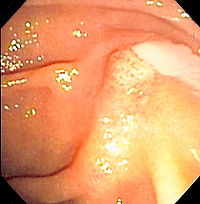
Photo from wikipedia
A man in his 40s who had undergone right lobectomy for hepatocellular carcinoma, developed jaundice due to hilar biliary obstruction associated with recurrence of the cancer. Multiple metal stents were… Click to show full abstract
A man in his 40s who had undergone right lobectomy for hepatocellular carcinoma, developed jaundice due to hilar biliary obstruction associated with recurrence of the cancer. Multiple metal stents were placed for the ventrolateral and dorsolateral segmental ducts, using a partial stent-in-stent method. At 5 months after the procedure, jaundice recurred with intrahepatic bile duct dilation, and the patient underwent endoscopic re-intervention. However, the guidewire could not be inserted into the lumen of the previously placed metal stent. The distal stent end was found to be tapering (▶Fig. 1), and ingrowth with/without overgrowth was suspected, based on X-ray fluoroscopic findings. Following insertion of a digital intraductal cholangioscope (SpyGlass DS; Boston Scientific Corp., Marlborough, Massachusetts, USA) into the bile duct, it was found that a stent–stone complex had formed at the distal stent end, and the lumen of the stent was completely obstructed (▶Fig. 2). Therefore, electrohydraulic lithotripsy was performed for the stent–stone complex. Thereafter, the lumen was visualized, and the guidewire was inserted under cholangioscopic guidance (▶Video1). Subsequently, stone fragments were removed using a balloon and basket catheter, and a stent was placed into the ventrolateral segmental duct. The patient’s symptoms and laboratory values showed improvement postoperatively, with no adverse events. Recurrent biliary obstruction mainly occurs due to ingrowth/overgrowth after placement of uncovered metal stents for malignant hilar biliary obstruction [1– 3]. Stent–stone complex is rare, but this Video 1 Stent–stone complex seen at the distal stent end on insertion of the digital intraductal cholangioscope into the bile duct. Electrohydraulic lithotripsy was performed, with subsequent visualization of the stent lumen. The guidewire was then inserted under cholangioscopic guidance. ▶ Fig. 1 The distal end of the previously placed metal stent was tapering, and therefore, it was not possible to insert the guidewire into the stent lumen. ▶ Fig. 2 Cholangioscopy showed formation of a stent–stone complex at the distal stent end, with complete obstruction of the stent lumen. E-Videos
Journal Title: Endoscopy
Year Published: 2018
Link to full text (if available)
Share on Social Media: Sign Up to like & get
recommendations!